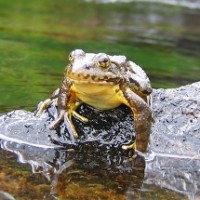Endangered species protection for Sierra frogs could impact recreational trout fishing
 The U.S. Fish and Wildlife Service said Friday that three amphibians native to the Sierra Nevada will be given protections under the Endangered Species Act, and the “critical habitat” areas include some popular fishing spots in the Sierra.
The U.S. Fish and Wildlife Service said Friday that three amphibians native to the Sierra Nevada will be given protections under the Endangered Species Act, and the “critical habitat” areas include some popular fishing spots in the Sierra.
Examples of “critical habitats” for the yellow-legged frogs include Bucks Lake in Plumas County; Gold Lake in Sierra County; Bowman Lake and Fordyce Lake in Nevada County; and Loon Lake and Caples Lake in El Dorado County, among others. The maps are here.
“Extensive research identifies two main reasons for their decline. First, trout were introduced in high-elevation lakes to draw recreationists and tourists to the area,” according to the National Park Service. “This created an imbalance in the natural world. Trout eat tadpoles and small frogs and compete with frogs for insects.”
The impact on recreational fishing, such as whether lakes will continue to be stocked with trout, are not yet known. A final decision on the critical habitat proposal is expected to be made early next year.
The Sierra Nevada yellow-legged frog and the northern Distinct Population Segment (DPS) of the mountain yellow-legged frog will be listed as endangered and the Yosemite toad as threatened under the ESA. The final rule announcing the actions is expected to publish in the Federal Register on April 29, 2014 and the final rule will become effective on June 30, 2014.
FOUND IN FISHING STREAMS AND LAKES
Once abundant, all three species have been in decline for several decades and are now found primarily on publicly managed lands at high elevations including streams, lakes, ponds, and meadow habitats located within national forests and national parks.
Studies show that populations of Sierra Nevada yellow-legged frog have declined by almost 70 percent while the northern DPS of mountain yellow-legged frog declined by over 80 percent. The Yosemite toad faces similar challenges with range-wide declines estimated at almost 50 percent. The amphibians are spread throughout 17 California counties: Alpine, Amador, Butte, Calaveras, El Dorado, Fresno, Inyo, Lassen, Madera, Mariposa, Mono, Nevada Placer, Plumas, Sierra, Tulare, and Tuolumne.
Habitat degradation, disease, predation and the effects of climate change are contributing factors to the documented decline of these species and continue to pose a threat to their recovery.
“This final rule is the result of exhaustive research, public comment, and scientific peer review,” said Jennifer Norris, Field Supervisor for the Service’s Sacramento Field Office. “While other moderate and minor level threats including historic logging, mining, grazing pressures and recreational use were evaluated, they were not considered significant factors in our determination.”
Being added to the federal list of threatened and endangered species gives protection to these animals from human-caused impacts that could jeopardize their continued existence while at the same time providing a means by which they can be eventually recovered and removed from the list.
1.8 MILLION ACRES OF CRITICAL HABITAT PROPOSED
On April 25, 2013, the Service published to the Federal Register a proposal to list the amphibians. At the same time, the Service proposed to designate 1,831,820 acres of critical habitat. A draft economic analysis for that critical habitat proposal was made available to the public on January 9, 2014. In that timeframe, the Service requested public comment and scientific information during several comment periods.
The Service also held two public meetings, two field hearings, and participated in three Congressional public forums sponsored by Congressmen McClintock and LaMalfa.
The Sierra Nevada yellow-legged frog and the northern DPS of the mountain yellow-legged frog are similar in appearance and behavior. They range from 1.5 to 3.25 inches in length and are a mix of brown and yellow, but can also be grey, red, or green-brown. They may have irregular lichen- or moss-like patchiness. Their belly and undersurfaces of the hind limbs are yellow or orange. They produce a distinctive mink or garlic-like order when disturbed.
The Yosemite toad is moderately sized, usually 1.2–2.8 inches in length, with rounded to slightly oval glands, one on each side of the head, which produce toxins to deter some predators. The iris of the eye is dark brown with gold reflective cells.
America’s fish, wildlife and plant resources belong to all of us, and ensuring the health of imperiled species is a shared responsibility. We’re working to actively engage conservation partners and the public in improved and innovative ways to conserve and recover all three amphibian species.
—By U.S. Fish and Wildlife Service, National Park Service and SierraCulture.com
